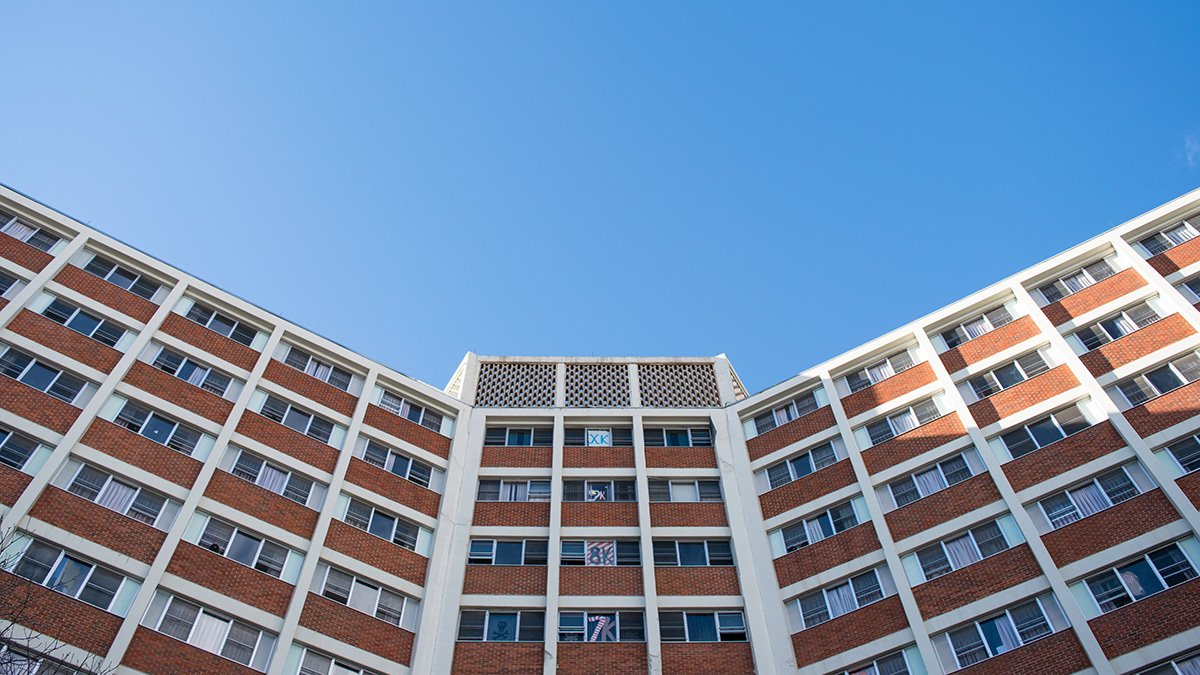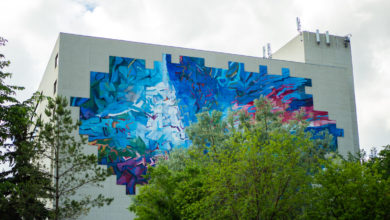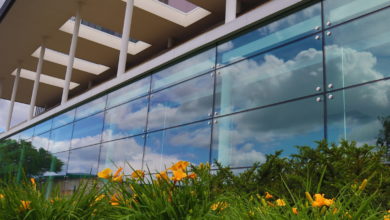What’s behind the cost of U of A residences?
Price can be a deciding factor when choosing where to live, but we don't always know why housing costs what it does. Let's find out.
 Christina Varvis
Christina VarvisThere’s a lot of big choices for incoming university students to make. Choosing what program and what university to attend is one of the big ones. And once students accept an offer from a university, they have another big choice to make: where to live.
For most, that choice begins with whether to live on campus, in residence, or off campus in a privately owned rental. There’s a lot to consider, like the commute to and from classes, living on their own for the first time, and living with or without roommates.
Katherine Huising, associate vice-president (campus services), oversees Residence Services. According to Huising, living in residence can make that transition easier for students. “We see higher GPAs, we see more connection with the institution, and [residence] provides more support for students.”
But as the cost-of-living crisis persists, the price of living on campus has an influence on students’ decision of where to live. Residence tends to be most expensive, but Huising explained some of the reasons behind the cost.
“We do not receive any university funding. We are required to pay our own weight,” Huising says
Residence is a self-funding service, meaning that the only funding it receives is what it generates on its own, Huising said. “We do not receive any university funding. We are required to pay our own weight.”
Huising added that although residence is financially independent from the university, it has access to university services like payroll and other accounting services. But, Residence Services pays about three per cent of its total operating costs for these services.
According to Huising, residence currently costs more to operate than it receives in revenue. She said residence is about a $40 million operation. Over the last few years, Residence Services has made investments to improve the situation for students. One of those large investments was renovating the Lister Towers completed in the last few years.
Despite the costs of operating, Residence Services plans to stand by its financial guidelines, Huising said. According to these guidelines, residence is expected to break even. Eventually, Residence Services will need to generate more revenue to be able to invest in reserve funds for ongoing maintenance.
U of A Media Relations provided The Gateway with a breakdown of the 2024–25 residence budget. The budget total is $49.5 million. All staffing costs, including Residence Life staff and benefits, account for 19 per cent of the budget. Regular maintenance and custodial costs account for 14 per cent. Utilities make up 10 per cent of budget.
Additionally, residences pay property taxes, which is four per cent of the total budget. Three per cent of the budget goes to paying for services from the U of A. Debt servicing also accounts for 27 per cent of of the budget. Capital projects such as renovations and updates to furnishings make up 14 per cent of the budget. Supplies and service costs account for nine per cent.
Huising said when she started, residence had about 60 different rates for different rooms on different floors in different buildings. After a lot of work, Huising said it has been simplified into five different rates based entirely on room type.
“We’ve been fortunate in what surrounds us in order to meet the demand of our students,” Huising says
At the June 14 Board of Governors (BoG) meeting, President and Vice-chancellor Bill Flanagan mentioned that the U of A’s residences are only at a 75 per cent occupancy rate. Huising confirmed this and clarified that Lister usually has the highest occupancy rate, in the high 90s.
This is different to what the University of Calgary has been facing in recent years. Both this year and last year, U of C hit its residency capacity limit. Students were waitlisted or had to find other alternatives. Huising attributes the difference to the U of A having a large amount of students that commute to campus. The availability of parking for those students has enabled that, she said.
The U of A’s location is likely another contributing factor to the occupancy rates, Huising said. The U of A is located much closer to downtown than U of C’s campus is and near more apartment buildings. “We’ve been fortunate in what surrounds us in order to meet the demand of our students.”
The U of A’s 10-year strategic plan SHAPE outlines a goal to increase enrolment by 16,000 students. Currently, residence has 5,200 beds. The Gateway asked about Residence Services’ plans to accommodate the increase of students. According to Huising, Residence Services have “sort of got ahead of the game.” It has opened three new residences in recent years, including Peter Lougheed Hall in 2017, Nipisiy House in 2018, and Thelma Chalifoux Hall tower in Lister in 2018.
“We feel we are in a good position to meet the initial growth targets,” Huising said. She added that Residence Services need more clarification on where the university’s focus is for recruiting students. If its focus is on students from Edmonton and surrounding areas, there aren’t the same pressures on residence as recruiting more international or out-of-province students would present.
U of A Media Relations told The Gateway that there are currently 4,000 students living in residence this academic year. The total number of applications received for a place in residence was 8,200 in the same year.
“You’re better off with pricing where it is, and find additional financial supports for those students who need it,” Huising says
A double room with a shared bathroom in any residence hall is $955 per month. A single room with a shared bathroom is $1,235 and a suite with a private bathroom is $1,395 per month. A shared apartment in residence costs $1,235 per month. A bachelor suite is $1,475 and a one bedroom apartment costs $1,845 per month. The monthly rent also includes utilities, internet, and tenant insurance.
According to Rental.ca’s July Rental Report, the average rent for a bachelor suite in Edmonton is $1,098 per month. The average rent for a one bedroom apartment in Edmonton is $1,404 per month. The average rent for a two bedroom apartment in Edmonton is $1,751 per month or about $875 per person. This doesn’t include utilities, internet, or tenant insurance.
| Double room | Single room shared bathroom | Single room private bathroom | Bachelor suite | One bedroom | Shared apartment | |
| U of A Residence | $955 | $1,235 | $1,395 | $1,475 | $1,845 | $1,235 |
| Edmonton rental average | N/A | N/A | N/A | $1,098* | $1,404* | $883* |
The Gateway asked about the cost of residence in comparison to the market rate in Edmonton. Huising said that Residence Services did a comparison with the private sector. The comparison found that residence isn’t more or less expensive than private apartments. Rather, it’s on par. U of A media relations clarified that residence used the Canadian Mortgage and Housing Corporation (CMHC) for its comparison. CMHC has not publicly released its data for the rental market in Edmonton.
The Gateway asked if Residence Services has looked at ways to lower the cost of residences. Huising said she hasn’t, though she’s had conversations with the Graduate Students’ Association (GSA) and the U of A Students’ Union (UASU) about that issue.
“Based on the demand we see, I don’t see value in reducing overall pricing,” she said. Huising thinks the conversation needs to focus on the supports available for students who struggle to afford the cost of residence.
“I have 5,200 beds and 60,000 students. Which of those 60,000 students get to be in reduced price housing? You’re better off with pricing where it is, and [finding] additional financial supports for those students who need it.”
The Gateway asked what supports are currently available for students. Huising was unsure and referred The Gateway to the Registrar’s Office for more information.
U of A Media Relations told The Gateway that it does not have a breakdown of how many students living in residence had to access financial aid from the university.
“Some students are well poised to afford it, some folks not so much,” Alva says
The Gateway interviewed Nolan Greenwood, the president of the Lister Hall Students’ Association (LHSA). LHSA advocates for the interests of students living in Lister Hall to Residence Services. Greenwood said much of LHSA’s advocacy focuses on maintenance issues, whether that’s broken doors or issues with the elevators.
Residence Services addresses issues in a timely manner, to the best of its ability, Greenwood said. He also said he understands why the cost of residence is what it is.
“I mean you’d obviously hope for lower costs but I understand why the cost is so high especially seeing how they just did renovations and … there’s some yearly maintenance that needs to be done.”
According to Greenwood, residence is worth it, even if the cost is a little high. “It’s a great opportunity to meet people. It’s a great community. [A] great way to get involved.”
Renson Alva, current vice-president (student life) (VPSL) of the UASU, spoke with The Gateway about residence. Alva himself lived in residence and worked as a residence assistant (RA) prior to being elected as VPSL. Now he works with residence associations and students to advocate for improvements to residence life.
He highlighted students’ concerns about the rising cost of residence, from North Campus to Campus Saint-Jean (CSJ) to Augustana. “Some students are well poised to afford it, some folks not so much.”
Alva mentioned the changes to residence rates across different buildings and units. According to Alva, the university brought the cost of newer residences, like Peter Lougheed Hall (PHL), down while units in HUB Mall or Lister went up.
“To me or most residents, [that] doesn’t make sense when brand new residences, like PHL, just lowered its rates but … HUB Mall or somewhere else on [North] campus just increased.”
According to Alva, Residence Services talk a lot about the added value of living in residence with the social and academic benefits of being on campus and the staff support. He said “we need to see residences convince us more on [the added] value as residence rates increase.” Additionally, Alva would like to see more consultation on the quality of residence and the meal plans as the cost of those increase.
Alva wants to make sure that residence is a viable option for students from all financial backgrounds. In a situation where someone is living in residence but is struggling to pay the rent for a time, Alva said the UASU is advocating to allow those students additional time. Other supports, such as scholarships or bursaries, can also help those students, he said.
Some students shared their thoughts on residence with The Gateway as well. Kelly Tigert said “the price of residence is too expensive for the lack of comfortable living.” They also mentioned issues with pests and a lack of remedies for that.
The Gateway asked Huising about concerns with pests and hygiene in residences. Huising said it’s an ongoing issue, and “we always have room for improvement.” Students with concerns are able to place a work order to have those issues addressed.
Huising said there’s also an education piece to it where residents are taught how to avoid attracting pests. “It’s a combination between education but also communication, and then it’s on us to improve how we’re addressing certain issues.”
Another student, Chloe Hagen, said they would recommend living in residence. “It’s easy being on campus and encourages you to do more things because you’re just a walk away.” While living on campus is good for students, Hagen also said the price of residence is higher than most rentals in Edmonton.
Ultimately, it’s up to each student to decide if residence is worth the price. It may be the better option for some but not for others. But as everything gets more expensive for students, especially housing accommodations, the choices only get harder.




